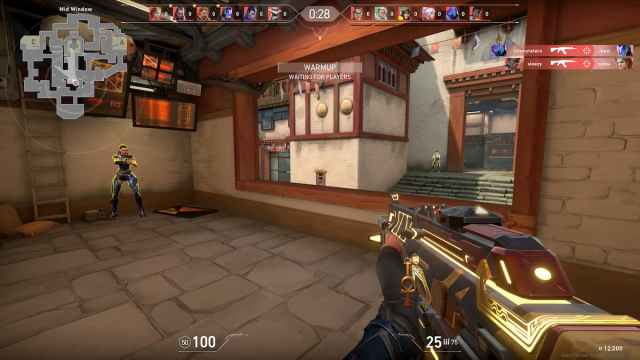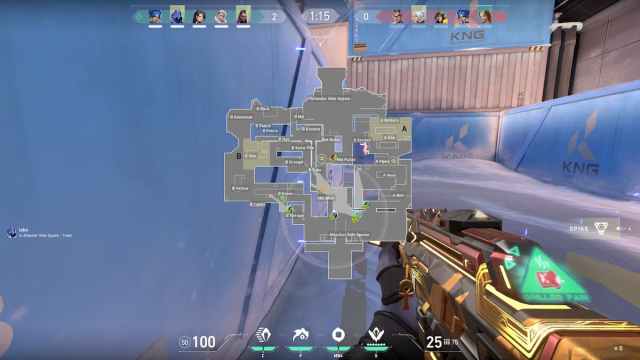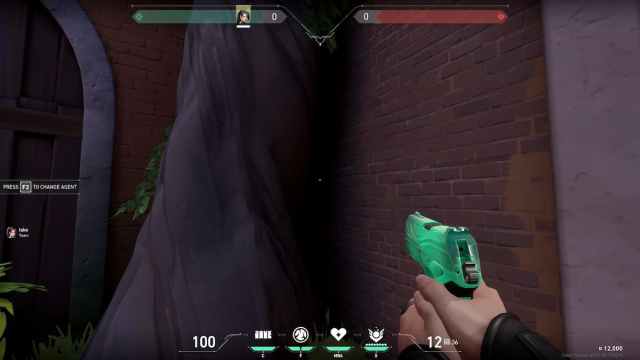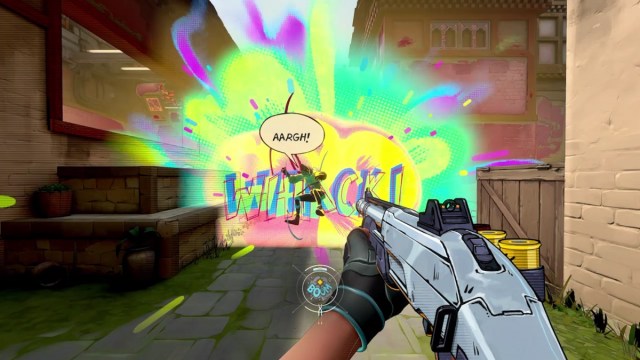Riot Games’ character-based tactical shooter Valorant can be daunting for a new player. It asks a lot from you – patience, game sense, map knowledge, concentration, quick reflexes, raw aiming skill, and more. All ingredients necessary to make your victory pie. Luckily, Valorant comes with a plethora of game settings that can be tweaked to fit your needs and make your playing experience the best it can be. We’ll go over the best Valorant settings on PC – from graphics and controls to audio and crosshairs.
Related: CS:GO to Valorant Sensitivity Conversion Guide
Accessibility and Enemy Highlight Color

Valorant has several color blind settings that change the color your enemies are highlighted as. If you find yourself watching professional Valorant players, you may notice that their opponents are highlighted in yellow while yours are red. While it ultimately boils down to preference, many players insist that the yellow highlights contrast much better with Valorant’s backgrounds and general color schemes. Try it out yourself and see if it helps you spot those enemies quicker.
Mouse Sensitivity
Click or be clicked. Mouse sensitivity is one of the most important settings of any first-person shooter, and finding that sweet spot for you will take a little trial and error. Fortunately, Valorant has The Range – a training area where you’re able to test guns, abilities, and practice your aim against sporadically spawning dummies. A lower mouse sensitivity means you’ll be sweeping your arm a bit wider to hit your shots, while a higher sensitivity means smaller movements using mainly just your wrist.
Map Settings

Your minimap can be your best friend in Valorant and will give you vital information that your teammates are sometimes unable to provide. Not only will it help you learn the layout of the map you’re on, but it will also indicate enemy and ally abilities, display your allies’ cones of vision, and reveal enemy positions that your allies can see. Additionally, a large, semi-transparent circle will surround your character on the map when you’re sprinting, indicating the radius of sound your footsteps are emitting – valuable information when pushing a site or attempting a flank. We recommend the following map settings:
- Rotate – Fixed
- Fixed Orientation – Based on Side
- Keep Player Centered – On
- Minimap Vision Cones – On
- Show Map Region Names – Always
Controls and Keybinds
Another area that comes down to preference, but an important area to tweak nonetheless. Hitting the right key for the right situation can be the difference between life and death in Valorant, so it’s imperative that you customize your keybinds in a way that’s comfortable and easy to remember. Some important keys to consider may be:
Use/Equip Ability 1/2/3/Ultimate
- If your weapons are the peanut butter, your abilities are the jelly in this Valorant sandwich. Make sure all four of these are bound to your favorite keys as you’ll be using them very often.
Equip Last Used Weapon
- Counter-Strike veterans will know this as the ‘Q’ key. Being able to swap from your primary weapon to your knife, and vice versa, can be extremely helpful when having to run from one site to another while still being able to draw your weapon at a moment’s notice.
Inspect Weapon
- When you have a flashy skin on a weapon, it’s very important to inspect it after a clutch play. This way, your team notices that not only are you a good player, but also have cool skins. This simply isn’t up for debate.
Team Voice Push To Talk Key
- Voice chat is pivotal in Valorant and, although not everyone is comfortable using it, is one of the most effective ways to relay information to your team. Valorant’s default push-to-talk key is ‘V’, and that’s terrible. Personally, I’m a big proponent of using a push-to-talk key that doesn’t require you to take any fingers off your movement keys, so I use Left-Alt as mine.
Ping (Tap) / Ping Wheel (Hold)
- Whether voice chat is for you or not, pinging serves as another effective method of information for you and your team. Sometimes, an opponent may be in a position that you just can’t find the words to describe. Aiming at that location and pinging it will help your team focus on that area and could help secure a kill.
Related: Valorant 5.03 PBE Patch Notes: Release Date, Nerfs, and More
Crosshair
Crosshairs come in all shapes and sizes, and Valorant has a hefty amount of customizable options available to make a crosshair that fits your playstyle. By default, your Valorant crosshair will have a setting called Movement Error on. This makes the shape of your crosshair dynamic, causing it to bloom outwards when moving and shrink when stationary. This is essentially a visual indicator of when your accuracy resets after moving, though, many players will insist that you turn this off and instead train yourself to recognize when your accuracy stabilizes.

See that tiny teal dot? Well, it’s actually a cross – which just speaks for its lack of size. By no means should you feel pressured to use a tiny, static crosshair with movement error disabled like mine, though, feel free to import my crosshair code into your game and tweak it to your heart’s desire:
0;s;1;P;c;5;h;0;0l;3;0o;0;0a;1;0f;0;1b;0
Video Settings
Naturally, in a game like Valorant, you want the highest frames per second you can attain. Playing in Fullscreen Mode, as opposed to Windowed, is one of the easiest ways to increase framerate. Turning VSync Off will also give you a boost of framerate, but if your monitor suffers from screen tearing, you may consider keeping it on instead. If your graphics card can handle it, crank all the settings to the maximum and enjoy. Otherwise, disabling features like Bloom, Distortion, and Cast Shadows can help increase performance for you.

Audio Settings
Lastly, Valorant offers plenty of audio settings to suit your needs. The majority of them, as usual, come down to preference, though Voice Chat is an area worth mentioning. At the very least, you should specify your Input / Output Devices and enable Team Voice Chat – even if you never plan on speaking yourself. Many players communicate solely through voice chat, and being able to hear your teammates is vital for securing a win. Not to worry, Valorant makes it very simple to mute other players if they become problematic by hitting the Esc key and un-checking Team Voice by their name.
Stand Tall — We Are Valorant!
Tailoring your Valorant experience to your liking can be the difference between you loving it or hating it. Take some time sifting through all the pages of settings, experiment with different keybindings and sensitivities, and find out what works for you. Before you know it, you’ll be top fragging your way to Radiant status.





Published: Aug 4, 2022 07:40 pm